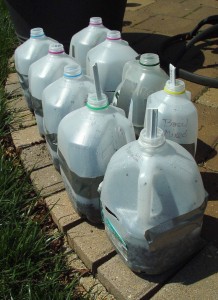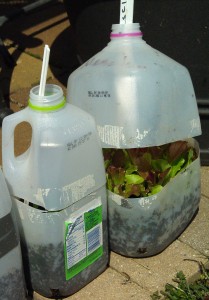Winter Sowing Seeds
May 20th, 2010
While most everyone else is at the garden center buying $4 six-packs of annual flowers, Pat King is filling her beds and pots for pennies on the dollar.
This avid Swatara Twp. gardener is reaping the rewards of an easy but little-known and even lesser-used frugal-gardening technique called “winter sowing.”
It’s a way to start your own plants from seed without the pitfalls of seed lights, overwatering woes and potential soil spills on the carpet.
King sows her seeds toward the end of winter in recycled plastic milk and tea jugs that she keeps outside on her back patio.
The containers act as mini-greenhouses.
The seeds come up at varying times – depending on their cold-hardiness – and by May, they’re ready to go into the garden.
This is the third year King has winter-sowed in jugs. It’s worked so well that she’s expanded from 11 to 36 jugs – enough to edge most of the patio.
“Years ago I tried to start seeds indoors,” she says. “But my tendency was to overwater. Or I’d forget to water, then end up in trouble again.”
She eventually gave up on the whole idea and came across winter sowing when looking for a gardening project she could do with some neighbor kids.
This was perfect – it’s easy, forgiving, cheap and demonstrates the miracle of how even huge plants like sunflowers originate with seemingly lifeless morsels as small as pinheads.
King uses both gallon and half-gallon plastic jugs, cut in half except at the handles. This creates flip-top containers.
She also cuts small holes at the base of each corner with an X-Acto knife. Those are for drainage.
Then she adds about 4 inches of potting mix to each container, waters it, and when the mix drains, plants the seeds.
“For bigger seeds, I poke them in 1 by 1,” she says. “The little ones, I just scatter them and tamp.”
For labels, she uses cut-up Venetian-blind slats or strips cut from plastic yogurt containers.
The containers then get duct-taped together and set outside with the caps off.
“That lets the rain in and any excess heat out,” says King.
She’s also found it’s best not to duct-tape the whole way around because cracks also let in rain and help ventilate on warm days like we’ve had this spring.
If it’s warm and dry, the seedlings need an occasional soft watering with a sprinkling can.
“These are like little greenhouses,” she says. “It’s very low-cost. My biggest expense was the $9 I paid for a bag of potting soil.”
Most beginners think there’s no way little plants will survive when cold nights hit.
That might be true of the more tender plants, but most perennials, herbs and hardier annual flowers and vegetables do just fine. Plants that naturally reseed themselves in our climate (larkspur, cleome, sweet alyssum, marigolds, nigella, cosmos, etc.) also do very well with winter sowing in jugs.
“If you think about it, even tomatoes, peppers and cucumbers will come up from seeds in the compost pile,” says King. “When you sow in late February to mid-March, you get at least a few weeks’ jump on the season. Plus a lot of seeds do want some cold to germinate.”
King has had success starting a variety of edibles this way, including basil, dill, parsley, lettuce, mesclun, Swiss chard, even tomatoes. She says it’s also great for experimenting with oddball flowers not commonly sold in plant form, and seed can be saved, traded or bought at far less cost than finished plants.
Most plants actually grow stronger and stockier in these outdoor mini-greenhouses because they get good light. Indoors, plants tend to get leggy because the combination of warm house temperatures and poor or artificial light makes stems stretch.
King says translucent jugs are perfect. They shield the young seedlings just enough on bright, sunny days but don’t block light like opaque jugs do.
“Most seedlings want some protection from full sunlight,” she says.
One other advantage is that outdoor-sown seedlings don’t need to go through the tricky process of “hardening off.”
As any indoor seed-starter quickly learns, you can’t just take indoor-grown plants and plant them outside in the garden. The light is just too much brighter, and the shock can white out or even kill young leaves.
The solution is gradually introducing the indoor seedlings to increasing light and air over a 7- to 10-day period before planting in the garden.
But since winter-sown plants have been outside from the beginning, they usually adjust from jug to ground immediately.
Not every plant takes to this method, but so many do that it’s easily worth the seed expense.
Tips abound online, but especially check out Trudi Davidoff’s WinterSown.org.
“I’m surprised more people don’t know about this,” says King. “It’s so easy.”
Also easy on the pocketbook.
Good annual flowers for winter sowing: Ageratum, sweet alyssum, snapdragons, calendula, celosia, cosmos, diascia, sunflowers, nicotiana, cosmos, cornflower, browallia, larkspur, nigella, Joseph’s coat, tithonia.
Good perennial flowers for winter sowing: Aster, astilbe, babys breath, gaillardia, liatris, coreopsis, gaura, penstemon, phlox, black-eyed susan, coneflower, Shasta daisy, yarrow, carnation, coralbells, baptisia, hollyhock, salvia, veronica.
Good edibles for winter sowing: Basil, dill, parsley, mesclun, cucumbers, lettuce, peppers, Swiss chard, cabbage, broccoli, cauliflower, kale, collards, melons, spinach, tomatoes, eggplant.










